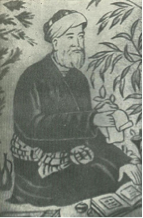 Jami was a 15th century Persian poet and theologian from the school of Ibn Arabi. A great scholar and mystical man, Jami also composed lyrics and idylls and was a respected historian.
Jami was a 15th century Persian poet and theologian from the school of Ibn Arabi. A great scholar and mystical man, Jami also composed lyrics and idylls and was a respected historian.
Jami was born in August 1414 and most accounts put his place of birth as Jam which is now known as Ghor Province in Afghanistan. An alternative place of birth is a small hamlet called Karjerd in Khorasan, though Jam seems the most likely. While Jami was still a young boy his father took the family to the much bigger city of Herat where Jami received an excellent education, studying mathematics, science, Arabic literature and Peripateticism (Greek philosophy).
When he began writing he took the name Dashti at first, because his father originated from Dasht. He soon changed it to Jami though, in honour of his own birthplace. He was keen to complete his studies in scientific subjects so a move to Samarkand was advised, this being acknowledged as the best place to be in the Muslim world for that purpose. He became a Sufi, following the Naqshbandi Sufi Order, and set out on a grand pilgrimage which would enhance his reputation across the whole of the Persian territories.
He became a Sufi shaykh (or sheikh) in 1453 and set about teaching that there is a clear distinction between two types of the Sufi faith. These are now called the prophetic and mystic spirit. He was an extremely pious man and devoted his life to Sufism. He claimed to have had a dream as a young man which told him that he had to take God into his life and become his faithful companion.
He followed the Sufi Sa’d-alDin Kasgari closely and their bond became ever closer when Jami married Kasgari’s granddaughter. They had four children, but three died in infancy. Alongside his all-important devotions he managed to write some eighty seven books and letters covering religious and scientific subjects. Some were written in prose style and others in verse. Remarkably he wrote a manual including accurate calculations and advanced scientific drawings on the irrigation system of Herat and it is still used for reference today. As a poet he was inspired by the ghazals written by another Persian sufi poet called Hafiz. A “ghazal” is a form of poetry which includes a refrain and rhyming couplets. Each line shares the same meter.
One of Jami’s most famous collections of poems is called Seven Thrones which features different stories including one about a prince who has a carnal attraction to his wet nurse. It was not unusual in those times for a deeply religious man to write about such an explicitly sexual subject using allegorical symbolism. His overriding philosophy though was that man should seek love first. This was emphasised by the story of a pupil who came to Jami asking to be taught and having never loved anyone in his life up to that point. His advice to the student was:

Here is an example of Jami’s lyrical style of poetry. It is an extract from an untitled quatrain:

Another of his collections of poetry is the story of his life set out in three separate sections covering his childhood to old age. The three different sections are:

When Jami died he received what would now be called a state funeral. It was conducted by the Prince of Herat and was a clear statement of the esteem in which he was held as a great Sufi Shaykh. His epitaph read:

Most historical accounts show that Jami died in November 1492, aged 78.

